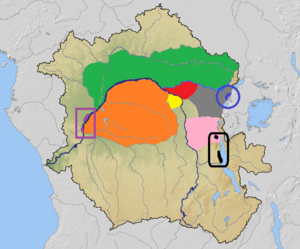Bouvier's red colobus facts for kids
Quick facts for kids Bouvier's red colobus |
|
|---|---|
| Conservation status | |
| Scientific classification | |
| Genus: |
Piliocolobus
|
| Species: |
bouvieri
|
 |
|
| Bouvier's red colobus range shown in purple (within the purple box) | |
| Synonyms | |
|
|
The Bouvier's red colobus (Piliocolobus bouvieri) is a special type of monkey. It was thought to be lost for a long time. Scientists rediscovered it in the Republic of the Congo in 2015. Before that, no one had seen one for about 40 years!
Contents
About the Bouvier's Red Colobus
The Bouvier's red colobus monkey has brownish-red fur. This fur is a bit lighter than its close cousin, the Pennant's colobus (P. pennantii). On its head, it has a patch of black or chocolate brown fur. This patch is smaller than the one on the Pennant's colobus. It also has a white chin and whiskers. A black band of fur goes from above its eyes to the sides of its head. Its eyes have big, pink rings around them.
This monkey has a long tail compared to its body. The tail is dark brown near its body. It then fades to a brownish-red color at the tip. The fur on the monkey's belly is lighter than the fur on its back. Each Bouvier's red colobus can look a bit different. Their faces can be light flesh-colored with dark cheeks and eyebrows. Or they can be darker all over, except for their nose and lips.
Where They Live
Bouvier's red colobus monkeys live in swampy forests. These forests are found around the Congo River. They live between the mouths of the Alima and Oubangui Rivers. Sadly, these monkeys do not seem to be afraid of humans. This makes them an easy target for hunters who hunt for bushmeat.
How They Are Classified
The Bouvier's red colobus was first described in 1887. This was done by a scientist named Alphonse Trémeau de Rochebrune. For many years, people thought it was just a type of Pennant's colobus. Its scientific name was Procolobus pennantii ssp. bouvieri.
But in 2007, another scientist named Colin Groves looked at it again. He decided it was its own separate species. He gave it the scientific name Piliocolobus bouvieri. This is the name scientists use for it today.
Their Status in the Wild
The Bouvier's red colobus is a very rare monkey. In 2008 and 2016, a group called IUCN said it was "critically endangered." This means it was in extreme danger of disappearing forever. They even thought it might be "possibly extinct." This was because no one had seen them since the 1970s. Scientists believed that at least 80% of their population had been lost. This was mainly due to hunting and losing their forest homes.
In 2019, IUCN changed its status to "endangered." This is still very serious, but it means there's a little more hope. They found new groups of these monkeys in the northern Republic of Congo. However, they are still very hard to find. Scientists are working hard to survey and protect them.
The Exciting Rediscovery
In February 2015, two explorers went looking for this lost monkey. Their names were Lieven Devreese from Belgium and Gaël Elie Gnondo Gobolo from the Republic of the Congo. They started their journey from a town called Owando.
They soon spotted the monkey while traveling on the Bokiba River. This was inside Ntokou-Pikounda National Park. They shared their exciting news in March. They even got help from the Wildlife Conservation Society to raise money for their trip.
In April, they showed the world the first-ever photo of the species. It was a picture of a mother monkey with her baby in a tree! Before this, scientists only knew about these monkeys from old museum samples. These samples were collected over 100 years ago. However, the local people living near the Bokiba River already knew about the species. In May 2021, an investigator named Jaap van der Waarde even managed to film one of these monkeys on video.
Images for kids



